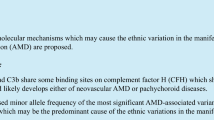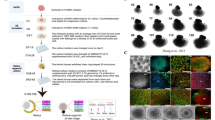Abstract
Study of retina specific genes would offer insights into retinal diseases and treatment. Based on the information from the gene expression profiles of mouse retinas, we here identified a mitochondria-localized glutamic acid-rich protein (MGARP/OSAP) as one of the highly expressed proteins in retina. Sequence analysis revealed that mouse and rat MGARPs have an extra insertion of four consecutive amino acid repeats at the C-terminus, while other homologues do not. MGARP was demonstrated to be localized to the mitochondria and overexpression of MGARP missing N-terminal region causes severe mitochondrial aggregation, implying an important role of MGARP in maintaining mitochondrial morphology. MGARP is highly expressed in mitochondria-rich layers, including inner segment of the photoreceptor, outer plexiform layer and ganglion cell layers of mouse retina. Far-UV CD spectrum analysis suggested that MGARP exhibits a large area of intrinsic disorder and the unusual position of its Tyr fluorescence suggested that Tyr residues in MGARP might form excimer and exist in an ionized state. These findings implied that MGARP be a good candidate for assembling certain ion channels on mitochondria membrane and have great potential to be involved in retinal energetic metabolism through mitochondria related pathway.





Similar content being viewed by others
References
Zrenner E (2002) Will retinal implants restore vision? Science 295:1022–1025
Fritsche LG, Loenhardt T, Janssen A, Fisher SA, Rivera A, Keilhauer CN, Weber BH (2008) Age-related macular degeneration is associated with an unstable ARMS2 (LOC387715) mRNA. Nat Genet 40:892–896
Mitchell P, Smith W, Attebo K, Wang JJ (1995) Prevalence of age-related maculopathy in Australia. The blue mountains eye study. Ophthalmology 102:1450–1460
Vingerling JR, Dielemans I, Hofman A, Grobbee DE, Hijmering M, Kramer CF, de Jong PT (1995) The prevalence of age-related maculopathy in the Rotterdam Study. Ophthalmology 102:205–210
Marx J (2006) Gene offers insight into macular degeneration. Science 314:405
Hollyfield JG, Bonilha VL, Rayborn ME, Yang X, Shadrach KG, Lu L, Ufret RL, Salomon RG, Perez VL (2008) Oxidative damage-induced inflammation initiates age-related macular degeneration. Nat Med 14:194–198
Hammes HP, Lin J, Renner O, Shani M, Lundqvist A, Betsholtz C, Brownlee M, Deutsch U (2002) Pericytes and the pathogenesis of diabetic retinopathy. Diabetes 51:3107–3112
Sivaprasad S, Jackson H (2007) Blood pressure control in type II diabetics with diabetic retinopathy. Eye 21:708–711
DeWan A, Liu M, Hartman S, Zhang SS, Liu DT, Zhao C, Tam PO, Chan WM, Lam DS, Snyder M, Barnstable C, Pang CP, Hoh J (2006) HTRA1 promoter polymorphism in wet age-related macular degeneration. Science 314:989–992
Edwards AO, Ritter R III, Abel KJ, Manning A, Panhuysen C, Farrer LA (2005) Complement factor H polymorphism and age-related macular degeneration. Science 308:421
Klein RJ, Zeiss C, Chew EY, Tsai JY, Sackler RS, Haynes C, Henning AK, SanGiovanni JP, Mane SM, Mayne ST, Bracken MB, Ferris FL, Ott J, Barnstable C, Hoh J (2005) Complement factor H polymorphism in age-related macular degeneration. Science 308:385
Yang Z, Camp NJ, Sun H, Tong Z, Gibbs D, Cameron DJ, Chen H, Zhao Y, Pearson E, Li X, Chien J, Dewan A, Harmon J, Bernstein PS, Shridhar V, Zabriskie NA, Hoh J, Howes K, Zhang K (2006) A variant of the HTRA1 gene increases susceptibility to age-related macular degeneration. Science 314:992
Ebrey T, Koutalos Y (2001) Vertebrate photoreceptors. Prog Retin Eye Res 20:49–94
Blackshaw S, Fraioli RE, Furukawa T, Cepko CL (2001) Comprehensive analysis of photoreceptor gene expression and the identification of candidate retinal disease genes. Cell 107:579–589
Lord-Grignon J, Tétreault N, Mears AJ, Swaroop A, Bernier G (2004) Characterization of new transcripts enriched in the mouse retina and identification of candidate retinal disease genes. Invest Ophthalmol Vis Sci 45:3313–3319
Li M, Zhang SS, Barnstable CJ (2003) Developmental and tissue expression patterns of mouse Mpp4 gene. Biochem Biophys Res Commun 307:229–235
Bradford MM (1976) A rapid and sensitive method for the quantitation of microgram quantities of protein utilizing the principle of protein-dye binding. Anal Biochem 72:248–254
Sreerama N, Woody RW (2000) Estimation of protein secondary structure from CD spectra: comparison of CONTIN, SELCON, and CDSSTR methods with an expanded reference set. Anal Biochem 287:252–260
Hennebold JD, Tanaka M, Saito J, Hanson BR, Adashi EY (2000) Ovary-selective genes I: the generation and characterization of an ovary-selective complementary deoxyribonucleic acid library. Endocrinology 141:2725–2734
Kinouchi R, Kinouchi T, Hamamoto T, Saito T, Tavares A, Tsuru T, Yamagami S (2006) Distribution of CESP-1 protein in the corneal endothelium and other tissues. Invest Ophthalmol Vis Sci 47:1397–1403
Lehrer SS, Fasman GD (1965) Excimer fluorescence in liquid phenol, p-ethylphenol, and anisole. J Am Chem Soc 87:4687–4691
Ardell MD, Bedsole DL, Schoborg RV, Pittler SJ (2000) Genomic organization of the human rod photoreceptor cGMP-gated cation channel beta-subunit gene. Gene 245:311–318
Colville CA, Molday RS (1996) Primary structure and expression of the human b-subunit and related proteins of the rod photoreceptor cGMP-gated channel. J Biol Chem 271:32968–32974
Grunwald ME, Yu W-P, Yu H-H, Yau K-W (1998) Identification of a domain on the b-subunit of the rod cGMP-gated cation channel that mediates inhibition by calcium-calmodulin. J Biol Chem 273:9148–9157
Körschen HG, Beyermann M, Müller F, Heck M, Vantler M, Koch KW, Kellner R, Wolfrum U, Bode C, Hofmann KP, Kaupp UB (1999) Interaction of glutamic-acid-rich proteins with the cGMP signalling pathway in rod photoreceptors. Nature 400:761–766
Batra-Safferling R, Abarca-Heidemann K, Körschen HG, Tziatzios C, Stoldt M, Budyak I, Willbold D, Schwalbe H, Klein-Seetharaman J, Kaupp UB (2006) Glutamic acid-rich proteins of rod photoreceptors are natively unfolded. J Biol Chem 281:1449–1460
Pentia DC, Hosier S, Cote RH (2006) The glutamic acid-rich protein-2 (GARP2) is a high affinity rod photoreceptor phosphodiesterase (PDE6)-binding protein that modulates its catalytic properties. J Biol Chem 281:5500–5505
Lin MT, Beal MF (2006) Mitochondrial dysfunction and oxidative stress in neurodegenerative diseases. Nature 443:787–795
Zeviani M, Carelli V (2007) Mitochondrial disorders. Curr Opin Neurol 20:564–571
Wang X (2001) The expanding role of mitochondria in apoptosis. Gene Dev 15:2922–2933
Green DR, Reed JC (1998) Mitochondria and apoptosis. Science 281:1309–1312
Acknowledgments
This work was supported by the following grants: the National Basic Research Program (also called the 973 Program) of China (No. 2006CB705700), the National Natural Science Foundation of China (No. 30671036). We appreciate Dr. Shaoyong Chen (BIDMC, Harvard Medical School) for discussions and reading of the manuscript.
Author information
Authors and Affiliations
Corresponding author
Electronic supplementary material
Below is the link to the electronic supplementary material.
Rights and permissions
About this article
Cite this article
Qi, S., Wang, Y., Zhou, M. et al. A mitochondria-localized glutamic acid-rich protein (MGARP/OSAP) is highly expressed in retina that exhibits a large area of intrinsic disorder. Mol Biol Rep 38, 2869–2877 (2011). https://doi.org/10.1007/s11033-010-9948-x
Received:
Accepted:
Published:
Issue Date:
DOI: https://doi.org/10.1007/s11033-010-9948-x




